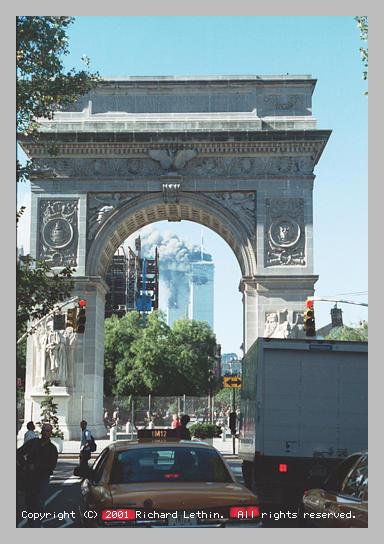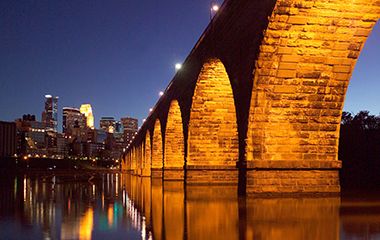
 48.8738°N 2.2950°ECoordinates:
48.8738°N 2.2950°ECoordinates:  48.8738°N 2.2950°E
Construction started
15 August 1806[1]
Inaugurated
29 July 1836[2]
Height
50 m (164 ft)
Dimensions
Other dimensions
Wide: 45 m (148 ft)
48.8738°N 2.2950°E
Construction started
15 August 1806[1]
Inaugurated
29 July 1836[2]
Height
50 m (164 ft)
Dimensions
Other dimensions
Wide: 45 m (148 ft)The Arc de Triomphe de l'Étoile (UK: /ˌɑːrk də ˈtriːɒmf, - ˈtriːoʊmf/,[3][4] US: /- triːˈoʊmf/,[5] French: [aʁk də tʁijɔ̃f də letwal] (![]() listen); lit. "Triumphal Arch of the Star") is one of the most famous monuments in Paris, France, standing at the western end of the Champs-Élysées at the centre of Place Charles de Gaulle, formerly named Place de l'Étoile — the étoile or "star" of the juncture formed by its twelve radiating avenues. The location of the arc and the plaza is shared between three arrondissements, 16th (south and west), 17th (north) and 8th (east). The Arc de Triomphe honours those who fought and died for France in the French Revolutionary and Napoleonic Wars, with the names of all French victories and generals inscribed on its inner and outer surfaces. Beneath its vault lies the Tomb of the Unknown Soldier from World War I.
listen); lit. "Triumphal Arch of the Star") is one of the most famous monuments in Paris, France, standing at the western end of the Champs-Élysées at the centre of Place Charles de Gaulle, formerly named Place de l'Étoile — the étoile or "star" of the juncture formed by its twelve radiating avenues. The location of the arc and the plaza is shared between three arrondissements, 16th (south and west), 17th (north) and 8th (east). The Arc de Triomphe honours those who fought and died for France in the French Revolutionary and Napoleonic Wars, with the names of all French victories and generals inscribed on its inner and outer surfaces. Beneath its vault lies the Tomb of the Unknown Soldier from World War I.
As the central cohesive element of the Axe historique (historic axis, a sequence of monuments and grand thoroughfares on a route running from the courtyard of the Louvre to the Grande Arche de la Défense), the Arc de Triomphe was designed by Jean Chalgrin in 1806, and its iconographic program pits heroically nude French youths against bearded Germanic warriors in chain mail. It set the tone for public monuments with triumphant patriotic messages. Inspired by the Arch of Titus in Rome, Italy, the Arc de Triomphe has an overall height of 50 metres (164 ft), width of 45 m (148 ft) and depth of 22 m (72 ft), while its large vault is 29.19 m (95.8 ft) high and 14.62 m (48.0 ft) wide. The smaller transverse vaults are 18.68 m (61.3 ft) high and 8.44 m (27.7 ft) wide. Three weeks after the Paris victory parade in 1919 (marking the end of hostilities in World War I), Charles Godefroy flew his Nieuport biplane under the arch's primary vault, with the event captured on newsreel.[6][7][8]
Paris's Arc de Triomphe was the tallest triumphal arch until the completion of the Monumento a la Revolución in Mexico City in 1938, which is 67 metres (220 ft) high. The Arch of Triumph in Pyongyang, completed in 1982, is modelled on the Arc de Triomphe and is slightly taller at 60 m (197 ft). La Grande Arche in La Defense near Paris is 110 metres high. Although it is not named an Arc de Triomphe, it has been designed on the same model and in the perspective of the Arc de Triomphe. It qualifies as the world's tallest arch.[9]

Wikipedia - Washington Square Arch, constructed of white Tuckahoe marble, was modeled by Stanford White on the Arc de Triomphe, built in 1806, in Paris (itself modeled on the Arch of Titus). It stands 77 feet m) (23high. The piers stand 30 feet (9.1 m) apart and the arch opening is 47 feet (14 m) high. The iconography of the Arch centers on images of war and peace. On the frieze are 13 large stars and 42 small stars interspersed with capital "W"s. The spandrels contain figures of Victory. The inscription on the attic story reads:
Let us raise a standard to which the wise and the honest can repair. The event is in the hand of God.
The north side of the eastern pier bears the sculpture George Washington as Commander-in-Chief, Accompanied by Fame and Valor (1914–1916) by Hermon A. MacNeil in which the President is flanked by Fame (left) and Valor (right). The western pier has George Washington as President, Accompanied by Wisdom and Justice (1917–18) by Alexander Stirling Calder (father of Alexander Calder) with flanking Justice (right) and Wisdom (left) figures In the latter sculpture, a hand holds a book bearing the Latin phrase Exitus Acta Probat ("the end justifies the deed"). These sculptures are commonly referred to as Washington at War and Washington at Peace, respectively. These figures and most of the rest of the carving on the arch was performed by the Piccirilli Brothers

